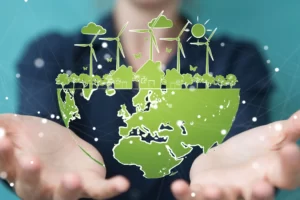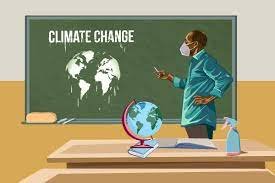Climate Change and Education are closely interwoven, and they create a crucial nexus that needs our immediate attention. As the effects of climate change worsen on our globe, education plays a critical role in promoting awareness, resilience, and sustainable solutions.
Globally, the necessity of addressing climate change has increased the significance of including environmental education in curriculum. It is essential to comprehend the science underlying climate change, its socioeconomic effects, and the need for eco-friendly actions in order to develop aware and accountable global citizens.
The idea that education may be a powerful instrument for combating climate change has gained traction in recent years. Academic establishments are progressively accepting the duty of furnishing pupils with the information and abilities required to alleviate the effects of climate change and adjust accordingly.
Initiatives encouraging green habits, creative problem-solving, and environmental awareness are spreading from elementary schools to colleges. This all-encompassing approach to Climate Change and Education fosters a sense of responsibility towards the world in addition to empowering people to understand the ecological concerns.
The symbiotic relationship between Climate Change and Education continues to be a keystone in the goal of a sustainable future, pointing the way toward environmental stewardship and a resilient global civilization.

Developing Ecology Knowledge for a Sustainable Future
The relationship between climate change and education becomes crucial for establishing a sustainable future in an era dominated by environmental issues. The substantial effects of climate change on education are examined in this article, which also looks at the various ways that curricula, teachers, and educational institutions work together to confront and mitigate the effects of global warming.
The Need for Environmental Education
Education and climate change interact at the need for environmental literacy. Understanding the wide-ranging effects of climate change becomes increasingly important for people from all walks of life as it gets stronger. Through the integration of climate science into their curricula, educational institutions play a critical role in cultivating this literacy. Students are taught about the fundamentals of climate change in every educational setting, from elementary schools to colleges. This provides them with the information they need to understand the complex interrelationships between environmental factors and human activity.
The Function of Academic Institutions in Addressing Climate Change
Academic institutions have a pivotal role in increasing consciousness and propelling climate action, rather than only serving as channels for the distribution of knowledge. The mutually beneficial interaction between these two elements is embodied in the term “Climate Change and Education.”
Organizations have the ability to embrace environmentally friendly practices by integrating renewable energy sources, developing sustainable infrastructure, and lowering their carbon footprints. These acts emphasize the importance of institutions in fostering a more sustainable future while also providing students with real-world examples and a sense of responsibility.
Read Also: Medical Scientists: Jobs, Career, Salary and Education Information
Education-Related Climate Change Initiatives: From Theory to Practice
Beyond merely theorizing, education and climate change are integrated. An extensive global network of projects and activities demonstrates a dedication to putting knowledge into practice. The Green Schools Initiative, for instance, promotes waste reduction and energy efficiency in schools by encouraging them to embrace eco-friendly practices. These kinds of initiatives show how climate change education may be applied practically and show how educational institutions can include sustainable practices into their operations.
Effective Climate Science Communication
One of the challenges that educators have is explaining difficult ideas in climate science to students of different age groups. Nonetheless, this difficulty offers a chance for creativity and diversity in the fields of education and climate change. By employing interactive technologies, multimedia materials, and real-world scenarios, educators can enhance the accessibility of climate science. Students can gain a concrete grasp of the issues at hand by traveling to locations impacted by climate change through virtual reality experiences, for example.
Extending the Curriculum: Going Beyond Science Classrooms
The advantages of incorporating climate change education into scientific classes are extensive. The term “Climate Change and Education” highlights the necessity of an all-encompassing educational framework that cuts beyond academic divisions. Students’ perspectives are enriched and a comprehensive grasp of the societal, economic, and cultural aspects of climate change is fostered when climate-related themes are incorporated into courses like literature, economics, and social studies.
Read Also: Scholarships For International Students
Promoting Global Citizenship via Environmental Stewardship
Education systems have a significant role in forming responsible global citizens. Education and climate change work together to encourage students to adopt sustainable habits and a sense of environmental responsibility. Educational institutions can work with international partners, exchange programs, and cooperative initiatives to actively involve students in global environmental challenges. Through highlighting the interdependence of the world and the collective accountability for mitigating climate change, educational frameworks aid in fostering a cohort of ecologically aware worldwide citizens.
Outside the Classroom: Outreach and Community Involvement
Education is not limited to the classroom, and the term “Climate Change and Education” emphasizes how crucial community involvement is. Educational establishments can start outreach initiatives, working with nearby communities to address environmental issues. Campaigns to plant trees, recycle, and organize neighborhood clean-ups not only support sustainable practices but also give students the tools they need to actively participate in change within their communities.
The Ability of Experiential Learning to Transform
One powerful instrument in the field of education and climate change is experiential learning. Students gain practical experiences that transcend abstract concepts through involvement in environmental research projects, field expeditions to climate-affected habitats, and hands-on work with sustainable technologies. In addition to enhancing comprehension, experiential learning promotes a sense of interconnectedness and environmental responsibility.
Read Also: Scholarships For International Students
Education on Climate Change in Higher Education
Institutions of higher learning are essential to the advancement of climate change education. Climate Change and Education is a buzzword that denotes the combination of cutting edge research, creative fixes, and policy talks. Universities may help mitigate the effects of climate change and adapt to them by launching research projects, offering degree programs that emphasize sustainability, and collaborating with businesses to adopt environmentally friendly business practices.
Measuring and Evaluating the Effects of Education on Climate Change
For teaching about climate change to get better over time, it must be measured. Assessment instruments that gauge students’ knowledge of climate science as well as their attitudes and actions toward sustainable practices can be used by educational systems. The phrase “Climate Change and Education” suggests a continuous dedication to improving instructional strategies and making sure the results are in line with the more general objectives of environmental sustainability.
Additionally:
Education shows itself to be a potent change agent in the face of climate change. The symbiotic relationship between climate change and education represents the transformational power of education in molding a generation dedicated to sustainability, in addition to the urgency of solving environmental concerns. Climate change education should be integrated into all educational settings, from primary schools to universities, in order to promote environmental literacy, global citizenship, and ultimately move mankind toward a more sustainable future.
Read Also: Internationalization of Career Services
What effect does climate change have on the requirement that environmental education be included in school curricula?
As a central global issue, climate change emphasizes how important it is to incorporate environmental education into school curricula. The phrase “Climate Change and Education” emphasizes how urgent it is to methodically handle this problem inside the educational institutions. Climate change exacerbates environmental issues including deforestation and biodiversity loss, disrupts ecosystems, and modifies weather patterns. Including climate-focused education is a calculated reaction to provide kids with a thorough awareness of these issues and cultivate a feeling of accountability.
What part can educational establishments play in educating people about the effects of climate change?
Education establishments are essential in spreading knowledge about climate change and its effects. By including the term “Climate Change and Education,” educational institutions can take a proactive approach to addressing this worldwide emergency. In order to raise public knowledge of the scientific underpinnings of climate change, its effects on society, and possible mitigation solutions, they might arrange workshops, seminars, and awareness campaigns. Institutions can also serve as role models for sustainable practices by implementing eco-friendly policies and green technologies into their daily operations to raise students’ awareness of environmental issues.
Exist any particular projects or initiatives that incorporate teaching about climate change at various academic levels?
There are a plethora of efforts and programs that incorporate climate change education at different academic levels, all of which are in line with the ideas of “Climate Change and Education.” Different educational stages have led to the development of curriculum frameworks and materials by organizations, governments, and non-profits. These programs ensure that students understand the complexity of climate science while creating a feeling of environmental responsibility. They accomplish this by combining age-appropriate curriculum, experiential learning, and real-world applications.

How can teachers explain difficult ideas in climate science to pupils in different age groups?
Teachers, who play a pivotal role in the intersection of “Climate Change and Education,” encounter the difficulty of explaining intricate concepts related to climate science to a wide range of age groups. Making abstract topics more approachable can be accomplished through the use of interactive teaching techniques, multimedia materials, and practical exercises.
Ensuring that the curriculum is adapted to various developmental stages guarantees that students understand the subtleties of climate science. A deeper grasp of the complexities of climate change is facilitated and engagement is increased by using case studies and making connections between scientific ideas and real-world experiences.
What are the possible advantages of including instruction on climate change in a larger educational framework?
There are several advantages to including climate change teaching into a larger educational framework. The phrase “Climate Change and Education” highlights how these two domains are related. First of all, by teaching vital information about problems and solutions related to climate change, it gets pupils ready for the future. Second, it develops analytical and problem-solving abilities, enabling people to support sustainable behaviors. An integrated approach also fosters a holistic awareness of the complex interactions between human activity and the environment, which instills a feeling of environmental responsibility.
How can educational systems help students develop sustainable practices and a feeling of environmental responsibility?
When educational systems are aligned with the ideas of “Climate Change and Education,” they can play a major role in helping students develop sustainable practices and a feeling of environmental responsibility. It is ensured that students experience ecological principles in a variety of circumstances by integrating environmental education across topics.
To give students practical experience, educational institutions can also start eco-clubs, plan environmental projects, and work with nearby communities. Education systems help to shape environmentally conscious citizens who actively participate in sustainable practices by fostering a culture that values sustainability.
Read also: The Internationalization of Community Engagement
Climate Change and Education: Additionally
Given the effects of climate change, it is essential that environmental education be incorporated into school curriculum. Through a variety of projects and programs created for various academic levels, educational institutions play a key role in increasing awareness about climate change and its repercussions. With the right communication techniques, teachers can teach pupils of different ages difficult ideas related to climate science. Wide-ranging advantages could result from this integration, including helping pupils become more environmentally conscious, developing critical thinking skills, and getting ready for the future.
By adopting an all-encompassing strategy, educational institutions help to build a generation dedicated to environmentally responsible behavior and sustainable practices. In order to meet the difficulties of our evolving planet, “Climate Change and Education” must work together harmoniously.
Trust you found our article on Climate Change and Education helpful. Follow our website for more interesting articles.
